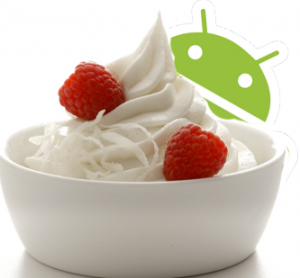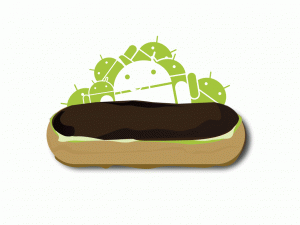Android 6.0 Marshmallow (Latest version till March)

Android 6.0 Marshmallow was announced on May 2015, but it named as Marshmallow on August 2015. And Google finally unveiled Android 6.0 Marshmallow on September 29, 2015.
Features of Android 6.0 Marshmallow :
- Android Marshmallow will support fingerprint scanners on phones natively.
- App links, also acknowledged as Intents, is a feature where if you click on a link in your email or a text message, it asks you what app you would like to open it with.
- With Android 6.0, you can set up automatic backups, which will back up apps and app environment to your Google Drive storage.
Android 5.1 Lollipop
 Android 5.1 Lollipop was announced on November, 2014.
Android 5.1 Lollipop was announced on November, 2014.
Features of Android 5.1 Lollipop :
- It sync with other Android devices and systems.
- Android Smart Lock pairs your appliance with other trusted devices (such as a sanctioned smartwatch) as a means of authenticating your identity.
- Amplified audio support allows for connection to a new dimension of audio equipment, including USB microphones, speakers, mixers and more.
- Phone theft is still a excessive issue, so Android 5.1 has a few new device security features.
Android 4.4 Kitkat
Android 4.4 Kitkat was announced on September 3, 2013.
 Features of Android 4.4 Kitkat :
Features of Android 4.4 Kitkat :
- The new phone app now automatically compile the users contacts depend on the people they talk to the most.
- The lock-screen widgets for music and movies apps now also endeavor the option to explore and jump to a specific part.
- Android 4.4 offers native platform base for printing, and includes APIs for operating printing and adding new types of printer support, according to Google.
- Apps that offer video can access the users highlight settings and adjust the display of the captions as per the users alternative.
Android 4.1 Jelly Bean

Jelly Bean was announced in June 2012. In android version numbers, it may not be a big jump, but it adds some important Android updates.
Features of Android 4.1 Jelly Bean :
- View photos you have taken rapidly by swiping from the camera to filmstrip view.
- Instead of simply show a list of Google web links after searching, Google Search results can now display answers to questions.
- Notifications now include spare information, such as photos or subject lines in emails.
- Widgets and apps politely move out of the way when you add new ones.
- A new gestures mode to improve convenience for blind users. In combination with speech output, it navigate the UI using touch and swipe gestures.
Android 4.0 Ice cream Sandwich

Android Ice cream Sandwich was well-established in May 2011. Android 4.0 Ice cream Sandwich was accomplish to merge Gingerbread together with Honeycomb.
Features of Android Ice cream sandwich :
- More storage space for apps.
- It improve speed of browser and smother browser.
- Menu button is replaced with a new action bar.
- For unlocking your phone, face recognition method is used.
- New video effects used for changing your look.
Android 3.0 and 3.1 Honeycomb

Honeycomb 3.1 was announced in May 2011. Without connecting to a computer, Android 3.1 adds base for plugging USB flash drives into your tablet to transfer files.
Features of Android Honeycomb :
- Home screens appear to rotate on a 3D roundabout as you swipe through them.
- Widgets are bigger and bolder to suit the tablet-size screen.
- A larger, multi-touch keyboard lets you hold down multiple keys to transiently switch between letters and numbers.
Android 2.3 Gingerbread

Gingerbread 2.3 was announced in December 2010. Android 2.3.3 was coming on phones in April 2011. It added new feature, the ability to run app for single core phone is designed for dual core processors.
Features of Android 2.3 Gingerbread :
- You can keep your eye on everything that you downloaded by a download manager.
- Apps are shuffled more accurately in the background, and it saving our battery and processing power.
- Front-facing camera used to support video calling and for your emo.
- On-screen keyboard gains number of shortcuts on the top and cursor help to select and copy text.
Android 2.2 Froyo
Froyo 2.2 was announced in May 2010.

Features of Android 2.2 Froyo :
- The portable Wi-Fi hotspot lets you contribute your phone’s 3G Internet connection with your other gadgets, over Wi-Fi.
- If your phone has a flash, it can be used to lighten your videos, too.
- Your settings merged your contacts and email in backing up to Google’s servers.
- Better Bluetooth affinity with docks and in-car speakers, and the addition of voice dialling over Bluetooth.
Android 2.0 and 2.1 Éclair
 Android 2.0 was entrenched in November 2009 and Android 2.1 Éclair was established in January 2010.
Android 2.0 was entrenched in November 2009 and Android 2.1 Éclair was established in January 2010.
Features of Android Éclair :
- Support for multiple Google accounts lets you stock up on all your Gmail.
- Searching within text messages and MMS messages.
- Camera settings including platform for a flash, digital zoom, white balance and colour effects.
- The Web brower gets a rejuvenate with a new address bar and thumbnails for a sneak peek at your bookmarks.
Android 1.6 Donut
Android 1.6 Donut was announced in October 2009. 
Features of Android 1.6 Donut :
- Support for more screen immovability opened the door to Android phones of distinct sizes.
- Google Maps exploration added free turn-by-turn sat-nav.
Android 1.5 Cupcake

Android 1.5 Cupcake was announced in May 2009.
Features of Android 1.5 Cupcake :
- Video recording was added to the camera, and the capability to upload videos successive to YouTube helped fulfil our dreams of immortality.
- Stereo Bluetooth facility provide you listen to music without using wires.
- The Web browser gets a speed improvement and copy and paste function.
Android 1.0 and 1.1
Android 1.0 and 1.1 was announced in 2008 and it is made by HTC.
Features of Android 1.0 and 1.1 :
- The Android Market served up apps without the stringent entry rules of the Apple App Store, leading to a responsive selection of apps, ranging from the abstract to the incredible.
- The Android browser made sieving the Web on your phone a ease rather than a pain, thanks to the ability to distribute pages rapidly and accurately.
- Google Maps used the phone’s GPS and Wi-Fi to analyze your location on an immeasurable map, so you need never be vanished again.
- Identify with our contacts and email online initially made us suspicious of sharing all our data with Google, but our privacy concerns were soon overcome by the erect convenience of achieve everything, from anywhere.